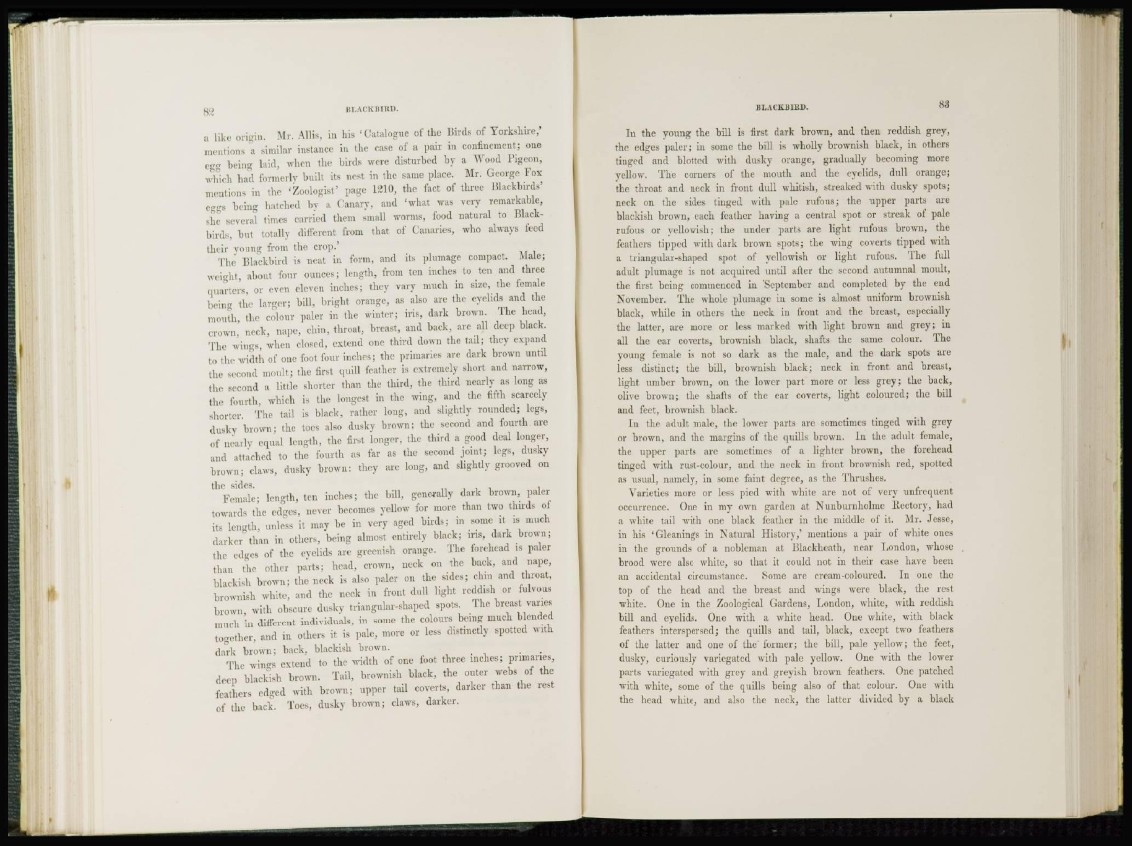
82 BLACKBIRD.
a like origin. Mr. Allis, in his 'Catalogue of the Birds of Yorkshire,'
mentions a similar instance in the case of a pair in confinement; one
egg being laid, when the birds were disturbed by a Wood Pigeon,
which had formerly built its nest in the same place. Mr. George Fox
mentions in the 'Zoologist' page 1210, the fact of three Blackbirds'
c/rgs being hatched by a Canary, and 'what was very remarkable,
she several times carried them small worms, food natural to Blackbird.,
bnl totally different from that of Canaries, who always feed
their young from the crop.'
The Blackbird is neat in form, and its plumage compact. Male;
weight, about four ounces; length, from ten inches to ten and three
quarters, or even eleven inches; they vary much in size, the female
being the larger; bill, bright orange, as also are the eyelids and the
mouth, the colour paler in the winter; iris, dark brown. The head,
crown, neck, nape, chin, throat, breast, and back, are all dec]) black.
The wings, when closed, extend one third down the tail; they expand
to the width of one foot four inches; the primaries are dark brown until
the second moult; the first quill feather is extremely short and narrow,
the second a little shorter than the third, the third nearly as long as
the fourth, which is the longest in the wing, and the fifth scarcely
shorter. Tin1 tail is black, rather long, and slightly rounded; legs,
dusky brown; the toes also dusky brown; the second and fourth are
of nearly equal length, the first longer, the third a good deal longer,
and attached to the fourth as far as the second joint; legs, dusky
brown; claws, dusky brown: they are long, and slightly grooved on
the sides.
Female; length, ten inches; the bill, generally dark brown, paler
towards the edges, never becomes yellow for more than two thirds of
its length, unless it may be in very aged birds; in some it is much
darker than in others, being almost entirely black; iris, dark brown;
the edges of the eyelids are greenish orange. The forehead is paler
than the other parts; head, crown, neck on the back, and nape,
blackish brown; the neck is also paler on the sides; chin and throat,
brownish white, and the neck in front dull light reddish or fulvous
brown, with obscure dusky triangular-shaped spots. The breast varies
much in different individuals, in some the colours being much blended
together, and in others it is pale, more or less distinctly spotted with
dark brown; back, blackish brown.
The wings extend to the width of one foot three inches; primaries,
deep blackish brown. Tail, brownish black, the outer webs of the
feathers edged with brown; upper tail coverts, darker than the rest
of the back. Toes, dusky brown; claws, darker.
BLACKBIRD. 88
In the young the bill is first dark brown, and then reddish grey,
the edges paler; in some the hill is wholly brownish black, in others
tinged and blotted with dusky orange, gradually becoming more
yellow. The corners of the mouth and the eyelids, dull orange;
the throat and neck in front dull whitish, streaked with dusky spots;
neck on the sides tinged witli pale rufous; the upper parts are
blackish brown, each feather having a central spot or streak of pale
rufous or yellowish; the under parts are light rufous brown, the
feathers tipped with dark brown spots; the wing coverts tipped with
a triangular-shaped spot of yellowish or light rufous. The full
adult plumage is not acquired until after the second autumnal moult,
the first being commenced in September and completed by the end
November. The whole plumage in some is almost uniform brownish
black, while in others the neck in front and the breast, especially
the latter, are more or less marked with light brown and grey; in
all the ear coverts, brownish black, shafts the same colour. The
young female is not so dark as the male, and the dark spots are
less distinct; the bill, brownish black; neck in front and breast,
light umber brown, on the lower part more or less grey; the back,
olive brown; the shafts of the ear coverts, light coloured; the bill
and feet, brownish black.
In the adult male, the lower parts are sometimes tinged with grey
or brown, and the margins of the quills brown. In the adult female,
the upper parts are sometimes of a lighter brown, the forehead
tinged with rust-colour, and the neck in front brownish red, spotted
as usual, namely, in some faint degree, as the Thrushes.
Varieties more or less pied with white are not of very unfrequent
occurrence. One in my own garden at Nuuburnhohue Rectory, had
a white tail with one black feather in the middle of it. Mr. Jesse,
in his 'Gleanings in Natural History,' mentions a pair of white ones
in the grounds of a nobleman at Blackheath, near London, whose
brood were also white, so that it could not in their case have been
an accidental circumstance. Some are cream-coloured. In one the
top of the head and the breast and wings were black, the rest
white. One in the Zoological Gardens, London, white, with reddish
bill and eyelids. One with a white head. One white, with black
feathers interspersed; the quills and tail, black, except two feathers
of the latter and one of the former; the bill, pale yellow; the feet,
dusky, curiously variegated with pale yellow. One with the lower
parts variegated with grey and greyish brown feathers. One patched
with white, some of the quills being also of that colour. One with
the head white, and also the neck, the latter divided by a black